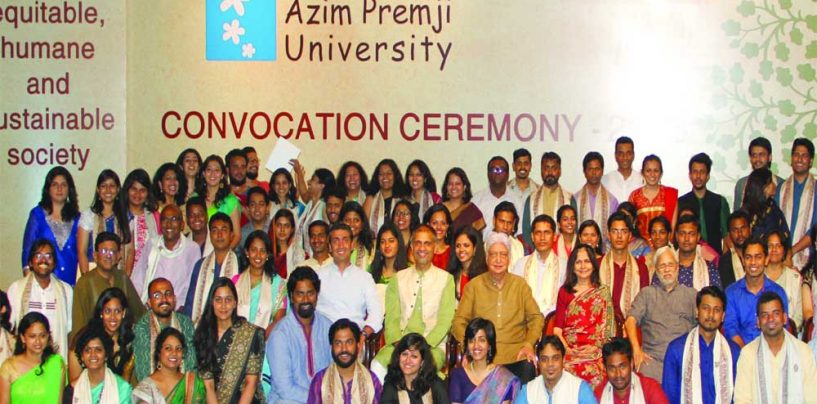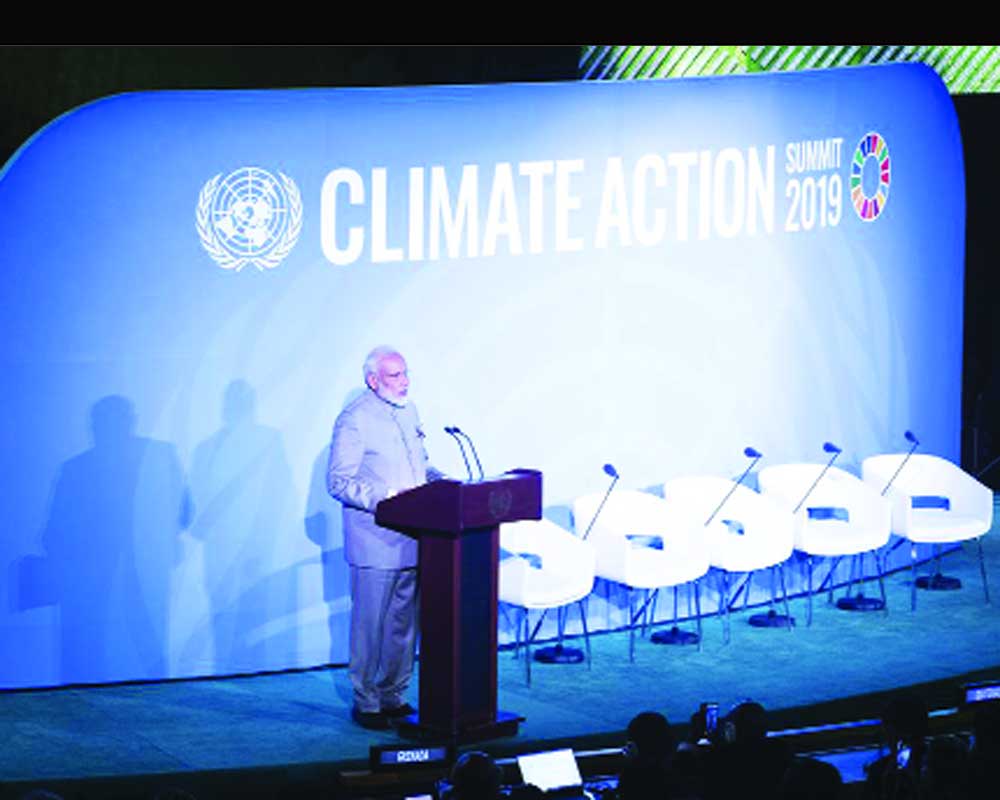
Understand the burning issue
by Spoorthy Raman / 15 November 2019With a robust combination of the right policies, economic incentives and awareness campaigns, the problem of managing crop residue in an environment-friendly manner can be addressed
Delhi, one of the world’s most polluted cities, is in the news again for its worsening air quality as the Government has been forced to close schools and declare a health emergency. The much-loved winter months in other parts of the country are a nightmare for the residents of Delhi-NCR as the area gets enveloped in a blanket of toxic haze.
With the Air Quality Index (AQI) reaching new levels each year and going as high as 1,200+ (classified ‘Hazardous’) this month, the city is suffocating, literally. Apart from coal and construction dust, vehicular emissions and smoke from Diwali firecrackers, stubble burning by farmers in the States of Punjab, Haryana and Uttar Pradesh (UP) are cited as the primary reason for this crisis.
While the Delhi Government has been trying to bring down pollution levels through its vehicle rationing odd-even scheme and by closing polluting factories and coal-based power plants among other things, biomass burning is something it has failed to stop. For this, it needs the cooperation of its neighbouring States and has no control over the farmers there.
Crop residue burning is a practice where farmers set their entire fields on fire after harvesting the rice crop, to make way for the next i.e. wheat. The sowing of rice is timed such that its intense water needs are met by the monsoon rains in the Indo-Gangetic plains and the crop is harvested just before winter starts. However, the result is a whopping 23 million tonnes of paddy residue in the fields that need to be cleared in a short span of 10 to 20 days, before the farms are readied for sowing wheat. If the farmers had more time between crops, they could have just left this biomass lie in the fields and let it turn to mulch, which is an excellent fertiliser. However, with such a short gap between the two crops, setting fields afire seems to be the easiest way to get rid of the stubble. This however severely degrades the ambient air quality of Delhi-NCR.
Taking cognisance of the consequences of stubble burning, the Government banned it in June, imposing fines on those who defied the diktat and recently the Supreme Court (SC) even pulled up the chief secretaries of the three neighbouring States and ordered them to ensure that farmers don’t burn crop residue anymore.
Nevertheless, the practice seems to have continued as growers contend that feasible, affordable and scalable alternatives are lacking. In an effort to encourage farmers to find alternatives to burning the residue, the SC had also directed the three States to pay Rs 100 per quintal of paddy straw to growers, but it doesn’t seem to have worked.
The atmospheric factors at play: People often wonder how a practice followed a few 100 km from Delhi-NCR has big implications. Here is the science behind this phenomenon. During winter, the region sees low wind speeds and temperature inversion — an atmospheric phenomenon where the temperature of the air near the surface is lower than that of the air higher in the atmosphere. Hence, when the pollutants from vehicular emissions and crop burning are released into the air, they are not dispersed but trapped in the lower layers of the atmosphere. As a result, the air quality takes a deep dive.
“Air pollution in cities like Delhi may be attributed to the growth of the metro and the pollutants from sources far away that get carried to the national Capital by the moving air or environmental conditions, which are unfavourable for the dispersion of pollutants,” said Prof Vinoj V from the Indian Institute of Technology (IIT), Bhubaneswar, talking about his study published in 2018. The study, among other things, had found that crop burning has been increasing at an alarming rate of 25 per cent since 2000.
It isn’t Delhi alone that takes the hit; other tier-2 cities in the region also seem to be affected by biomass burning for similar reasons. A 2019 research, which investigated the source of pollutants in 20 Indian cities other than Delhi, found that in places like Amritsar, Chandigarh and Ludhiana, crop residue burning, along with emissions from power plants and seasonal dust storms contributed to about 50-52 per cent of particulate matter.
In essence, the timing of winter-related atmospheric phenomena, coupled with the surge in emissions when the fields are set on fire, is a perfect pollution cocktail.
The health and economic costs of stubble burning: It is well-known that inhaling polluted air can lead to severe health conditions like lung cancer, diabetes, cardiovascular diseases, asthma, bronchitis and dementia. Not just this, air pollution also adversely affects crop yields in India. But, what really is the economic cost of stubble burning in these maladies?
A study, published by researchers at USA’s International Food Policy Research Institute and Oklahoma State University, pegs that number at $30 billion, including the economic loss and associated health costs. It found that about 14 per cent of acute respiratory infections, recorded in Haryana, Punjab and Delhi in 2013, could be attributed to stubble burning. Researchers estimate that living in areas where there is intensive crop burning increases the chance of acute respiratory infections three-fold, with children under the age of five being the most affected.
Crippled policies adding to woes: As most studies have pointed out, a robust combination of the right policies, economic incentives and awareness campaigns are the need of the hour to curb the “burning” problem of air pollution. Badly-designed policies could have unintended effects on air quality, as shown by a research from the International Maize and Wheat Improvement Center in India and Mexico and the Cornell University, USA. It showed that groundwater conservation policies, introduced in 2009 in Punjab and Haryana, could have contributed to the rise in stubble burning.
Although rice is a lucrative crop for farmers, it is water-intensive. Hence, the ‘Punjab Preservation of Subsoil Water Act’ and the ‘Haryana Preservation of Subsoil Water Act’ banned the transplantation of rice before monsoon to conserve groundwater. As the monsoon arrives in these States in July, the crop is harvested in early November, forcing farmers to clear their fields as soon as possible for wheat sowing. Using satellite data, the study found that prior to 2009, about 40 per cent of rice was harvested by late October and this number declined to 14 per cent after the law was enforced. The number of fires went up from 490 per day during late October prior to 2009, to 681 per day, peaking around early November. The average daily PM2.5 concentrations in November were also found to be 29 per cent higher after the groundwater Acts were passed.
With the clamour for alternatives to stubble burning increasingly being heard, science may have solutions, as shown by a 2019 study. It analysed 10 alternatives to stubble burning and found that contrary to what farmers believed, these methods were not only environment-friendly, but also profitable. Among them is using Happy Seeder, a machine that can sow wheat despite the presence of rice straw in the fields. This yielded nearly 10-20 per cent increase in profits or about Rs 11,498 per hectare on an average. The profits come from lower land preparation cost and the reuse of the crop residue, which increases soil moisture and benefits the long-term health of the soil.
However, these benefits come at a cost of Rs 2.4 billion — necessary to produce about 16,000 Happy Seeders to cater to 50 per cent of the rice — wheat cultivation areas. With a meagre subsidy of Rs 2,000 provided by the Government for purchasing machines to manage crop residue, machines like Happy Seeders are unaffordable to many farmers, leaving them with no options but to set fields on fire.
As most of these studies have pointed out, with a robust combination of the right policies, economic incentives and awareness campaigns, the pressing problem of managing crop residue can be addressed. It is about time that policymakers took note of such insights and acted to provide us all with clean air to breathe — a basic necessity of life.
Writer: Spoorthy Raman
Courtesy: The Pioneer

Answer to power woes blowing in the wind?
by Kota Sriraj / 14 November 2019The speed at which India is progressing on its wind energy agenda is not encouraging, whereas the targets the country has set itself are very ambitious. Why is there such a major disconnect between plan and action?
Many environmental sceptics will write off wind energy as a resource that has literally gone with the wind and rightly so, as India still has a long way to go before it can say that wind power has come to play a pivotal role in becoming the alternate source to fossil fuels.
Having said this, wind energy obviously cannot be written off as it has tremendous potential that is just waiting to be tapped. The specific circumstances in India are not able to create an enabling environment for the full-fledged harnessing of this amazing pollution-free sustainable and renewable power resource.
The speed at which India is progressing on its wind energy agenda is not encouraging whereas the targets the country has set itself are very ambitious.
Why is there such a major disconnect between plan and action? Is it due to the lack of a cohesive vision?
For instance, India has set an ambitious target of achieving 175 gigawatt (GW) renewable energy capacity by 2022. As per the Ministry of New and Renewable Energy’s figures, at the end of 2018, India had an installed capacity of 35 GW. Hence, the jump from 35 GW to 175 GW by 2022 sure looks ambitious and maybe a tad unachievable, not because the target is high but because there is an absence of aggressive policy-backed implementation efforts and initiatives to achieve the same.
The world is witnessing a major shift from fossil fuels to renewable energy, mainly due to the rising awareness regarding their ill-effects. Thanks to this awakening, the cost of renewable energy infrastructure is coming down rapidly elsewhere in the world, but in India this fall in installation rates is not translating into renewed enthusiasm for wind energy and this is concerning. The full potential of wind energy, if and when harnessed, has the ability to mitigate climate change and pollution together. In our renewable energy sector, the emphasis on grand plans and commitments is given primary importance, whereas time-bound execution of projects is sorely missing. Yet another pressing factor is going to make reliance on renewable energy compulsory sooner than later. According to a study by the Indian Statistical Institute, the projected domestic social cost of coal-based power generation will be too high by 2024-25. This will necessitate reduction in building of new coal-based power plants and render the operations of the existing ones unviable. At a time such as this, a fully-developed portfolio of renewable energy options will be able to shoulder the burden of India’s energy demand. However, this portfolio, with a robust GW capacity cannot happen overnight and needs a sufficient run up, which is not happening in the country today.
Senior environmentalists and policymakers must understand that though time is short, it is also ripe for harnessing wind energy. This is because the technology is available and energy storage is improving exponentially as a lot of innovation is taking place. Hence, it will be much more easy to adopt wind energy today than ever before.
Wind energy cannot be seen as a back-up resource or a plan B. Renewable power sources, especially the trio of solar, wind and hydro power are going to be the mainstay of the future energy sector of the country. To make this happen India must invest appropriately also.
According to the estimates of the US-based Institute for Energy Economics and Financial Analysis (IEEFA), the country will require $500 to $700 billion in renewable energy and supporting grid investment over the coming decade in order to meet its renewable energy targets. Some immediate steps can go a long way to counter the wind energy generation slowdown.
India must first, bring policy consensus and ensure that implementation and execution remain the strong points of its policy. Also, a monthly monitoring of the hurdles being faced by the renewable energy sector will help in smooth scaling up of the wind energy portfolio.
In addition to this, the authorities may want to prepare a compelling mix of wind and solar energy generation options for small and medium investors as this will raise awareness and present a major business opportunity too. The proper and viable storage of energy is an ongoing issue, which needs to be taken care of as well.
Wind energy has a potential that is still waiting to be tapped and India can easily sail through any future energy crisis only if it has got the wind in its sails.
Writer: Kota Sriraj
Courtesy: The Pioneer

Learn from great CEOs
by Hima Bindu Kota / 13 November 2019Their greatness lies in the fact that not only have they created profitable enterprises; they have also created brands that are etched forever in the imagination of consumers
One can decidedly differentiate between an ordinary Chief Executive Officer (CEO) and a great one. Great CEOs are exemplary visionaries, with superlative managerial and leadership skills. They are admired by colleagues and common men alike and are considered idols by millions of young aspiring leaders dreaming of making it big in the corporate world. Their greatness lies in the fact that not only have they created profitable enterprises; they have also created brands that are etched forever in the imagination of consumers. So what are the leadership principles and management philosophies that drive these icons and enable them to take their organisations to stellar heights?
As Brad Feld, an American entrepreneur and venture capitalist, said, “Don’t be afraid to have a big vision, but make sure it’s a clear one”, clarity of vision is one of the main traits of great CEOs.
Taking an example of Steve Jobs, an unconventional leader who demanded excellence from his staff and was controversial for his blunt delivery of criticism. However, his sheer genius; his amazing ability to articulate his vision and dexterity to take his people, investors and customers with him on his journey made him an exceptional leader. Jobs had an exceptional clarity of vision and excelled at designing minimalist devices that broke barriers in computer speeds. He created an ecosystem which could stand alone or work together in an interconnected way-like an iPod connected to a Mac connected to an iTunes store. Apple could manage vast amounts of information through division of labour among the systems. For example, the Mac controlled system administration while iTunes fetched content from cloud storage, freeing the device to concentrate on playing the music. Jobs was motivated more than anything to feel he had made a solid and positive impact on the world during his lifetime. And since he had such high expectations from himself, he was able to achieve excellence.
Jack Welch, perhaps the greatest corporate leader of the 20th century, was the youngest CEO of General Electric (GE) when he took over in 1981. He followed an incremental leadership style and during his two-decade stint, the net worth of GE improved by a whopping 4,000 per cent. He is a management theorist and strategic thinker who championed new initiatives like Six Sigma quality, differentiation and e-business.
Bill Gates, listed as the richest person on this planet for 12 consecutive years, is also a man of colossal vision. He envisioned every person on this planet to have a computer and every computer, a programme, designed by Microsoft. Since then, he has worked tirelessly to achieve his vision. In this process, he has been instrumental in the IT revolution that the world has witnessed. Great CEOs, apart from adding to the bottomline of the company contribute to the society in a big way. It would be hard to talk about the life of Bill Gates and not discuss philanthropy and humanitarianism. Heeding to his mother’s advice before she passed away due to breast cancer, Gates has always taken a selfless approach to his leadership, spending considerable money and time in philanthropic efforts to give to others. The Bill and Melinda Gates Foundation has donated billions of dollars to causes all over the world, making significant differences in the lives of children and adults. This level of giving back illustrates Gates’ character and focus on social responsibility as a global corporate citizen. It also shows that his pursuit of solutions and making life better went beyond just making a profit. Instead, it was about driving significant change in the world that would make a difference for those who need it the most.
Indra Nooyi, who is an iconic leader, consistently ranked among the 100 most powerful women, when she was the CEO of PepsiCo, the world’s second largest food and beverage company in the world, and was at the helm of managing an employee strength of 30,000 and selling in around 200 countries around the world. She believed in developing two balance sheets: One was to provide return to shareholders and the other was to provide return to the environment.Under her leadership, PepsiCo focussed on people and planet in addition to profit. Nooyi had worked tirelessly to reduce the use of energy, water and packaging and simultaneously providing a great workplace for its employees and associates.
Great CEOs show that great works are performed not by strength but by perseverance. “It’s not where you start out in life that matters, but where you end up”.
This adage fits Ursula Burns perfectly. Born in the poor neighbourhood of Manhattan to immigrant parents and raised by a single mother, she rose to become the first female African American CEO of a Fortune 500 company, Xerox and also holds the honour of being the first woman to succeed another woman CEO, Anne Mulcahy. Having joined Xerox in 1980 as a mechanical engineering summer intern, Burns progressed through the corporate echelons to become the CEO from 2009 to 2016. At present, she is the Chairperson and CEO of VEON, a senior advisor to Teneo, and a non-executive director of Diageo since April 2018. She is also the member of the board of directors of Uber. She worked very hard to rise above her underprivileged background and did not use her background as an excuse. She worked with perseverance to reach the top of the corporate world and worked hard to return Xerox to profitability. NR Narayan Murthy, a role model for every Indian, is an apt example of “Simple living, high thinking”. He is a billionaire with net worth of about $230 crore but still flies economy and drives around in a simple car. Murthy’s life is an inspiration to all of us and gives a strong message that world-class businesses can be created based on transparency and good governance. Born in a middle class family in Sidlaghatta, Karnataka, the odds of life were no match to this brilliant and enthusiastic person, who, through his discipline and determination created a “Great Indian IT Success Story.”
Infosys, today, is one of most respected IT companies in the world with footprints all across the globe and is the second-largest IT company in India by revenue. But did you know that his first entrepreneurial venture, Softronics, failed to take off? One of the initial challenges faced by Murthy was the inability to take admission in the prestigious Indian Institute of Technology (IIT) even after earning a high rank and scholarship as the grant was not enough to cover his studies. Since his father was unable to fund his education, he enrolled into a local engineering college but later did his post-graduation from IIT.
Similarly, the failure of his first entrepreneurial venture, Softronics, did not stop him from establishing Infosys and lead it to stellar heights. Murthy follows Mahatma Gandhi’s policy of “practice what you preach.” He has always led by example and believes that the primary responsibility of a leader is to give hope and confidence in the face of adversity.
Taking care of people is one of the biggest attributes of great CEOs. Murthy has been generous in rewarding employees with stock options. Personally, he has given away stocks worth of Rs 50,000 crore to his employees. He reiterates that performance should be rewarded suitably. In Infosys, drivers, electricians and secretaries are among millionaires due to their stock options. Indra Nooyi was also a caring, humane CEO who took care of her employees by being in touch with them and understanding their concerns. She even wrote “thank you” letters to the parents of the employees to show her appreciation to them.
Similarly, Ken Chenault, the former CEO of American Express, believed in reaching out to each employee. He made it a point to answer to each and every mail he received from any of his employees. He travelled around the world to meet staff at different locations from around the globe.To further connect personally with his people, he used to run an open operation where anyone could talk to him.
Great CEOs, because of their innate quality of perseverance and contribution to society, ensure stability and growth of their organisations making them the best in the world. They live by their principles and lead by example, making them exemplary leaders of the corporate world.
Writer: Hima Bindu Kota
Courtesy: The Pioneer

‘I still can’t bear to be near the remains of the wall’
by Fanny Melle / 11 November 2019I fled the East for West Berlin and found out that my ‘friends’ had been informing on me to the Stasi, recalls Fanny Melle
I’ve lived in Berlin for 30 years — but have never gone near the Wall or what’s left of it. I spent so long trying to escape over it that I can’t bear to be near it. Like most West Berliners on that night in November 1989, I sat at home alone watching East Germans flood through the gates at Bornholmer Straße on TV.
I found that moment bittersweet: Having finally managed to escape the East in 1985, abandoning my family and friends, it fell just four years later, producing revelations about my life as an East Berliner just four years earlier along with the rubble.
I had grown up in East Germany near Karl-Marx-Stadt (now Chemnitz), but at the age of 28 I was granted permission to leave; East Germany had signed up to the Helsinki Accords, which made it theoretically possible for citizens to apply to emigrate to the West. In reality, though, the process was tortuous and opaque: You had to apply in person every year and usually your application would be declined without explanation.
The first time you applied, you were immediately blacklisted by the SED (the East German Communist Party), making it difficult to get things like jobs and flats. If, years later, your permission did finally come it came without warning and you were given just four weeks to settle your affairs and go.
So on December 6, 1985 my parents drove me and my then-husband to Friedrichstraße Station, which straddled the Berlin Wall, with platforms in both the East and the West. My parents were very political, both members of the SED. My father was a head teacher and my mother worked as a typist for the party’s Agricultural Department. They were dedicated to East Germany and couldn’t comprehend why I was leaving. It really broke their hearts. They left us at the cavernous glass departures hall at Friedrichstraße station, which we called the “Tränenpalast” (the Palace of Tears). In a very narrow corridor, the GDR authorities stripped me of all my papers, making me officially stateless, and I was free to go.
As artists in the East, my ex-husband and I couldn’t exhibit or publish our work, we weren’t allowed to study and we were under constant surveillance. We knew nothing about West Berlin. All information about the western half of the city was suppressed: on our maps, West Berlin was just a blank white space in the middle of East Germany. When we arrived we drove through the city — it was Christmas and the bright lights made me so dizzy that, on my first night, I didn’t sleep a wink. For months afterwards I had a recurring nightmare that I was visiting my parents in Karl-Marx-Stadt, and when I went to get the train back to the West the door of the station was locked. There was, of course, joy at having left, particularly having the freedom to paint and draw and the fact I had access to proper artists’ materials for the first time, rather than having to paint on old sheets stretched over a bed frame. But there were things I struggled with in the West.
People seemed so uptight to me. Because almost no one in the East had their own phone, if you wanted to talk to someone you just turned up at their flat. Sometimes friends would knock on the door at three in the morning and you would pull on your clothes and head out with them for a drink. I had also never experienced sexism before I left East Germany. When I had my first job interview in West Berlin as a window dresser, they said they liked me but I was 28 so would probably get pregnant soon, and gave the job to a man. It took me months to find work. Although we were free, the Stasi continued to watch us. I later discovered that they had tapped my phone calls back home to my family; one time an old friend from Karl-Marx-Stadt turned up at my door saying that he had been given permission to visit the State Library in West Berlin and could he borrow 10 marks. It turned out he was also working for the Stasi and wanted to check on me and my husband’s whereabouts. Not that we had done anything particularly seditious — we just wanted the freedom to do our work. But in East Germany you didn’t need to do much wrong to attract the attention of the secret police.
The biggest change for me when the Wall fell was that I could see my family again. My sister-in-law came over and visited me in West Berlin and was disappointed by how modestly I lived — I was a window dresser and an artist and earned very little. Where was my video recorder, she wanted to know. Where were my fitted wardrobes?
I went straight over to our town near Chemnitz to visit my mother and father, although my mother was very sick by then. They were still sad that I’d left, but we talked everything through and the best point we could reach was to begrudgingly agree that neither the East nor the West were perfect.
The fall of the Wall meant that the Stasi files were opened up and I was able to apply to the new Stasi Records Agency to view all of the files that had been kept on me.
I’d been part of a large artists’ circle in the East and my first solo show at a local youth club was a sell out. My files, though, revealed that the Stasi had paid the director of the club to buy the drawings to keep my artists’ circle together so they could keep spying on us all, hoping, I suppose, that our subversive meetings and publications would lead to one of us doing something really treasonous. I was devastated. But what really broke my heart was the amount of fellow artists and friends who had informed on me. I cut out anyone that had betrayed us.
Thirty years on, Berlin is still changing so fast that I sometimes wonder how long I’ll have a place here. But I’ve been in the West longer than I ever lived in the East and I don’t see myself as East German anymore. I suppose, finally, I feel like a West Berliner.
Writer: Fanny Melle
Courtesy: The Pioneer

No piecemeal solutions
by Rajeev Ahuja / 08 November 2019Good governance is not just about absence of corruption; it is also about effective decision-taking. People are wanting to see such examples from their elected leaders
Imagine this. It’s winter time once again. Post-Diwali, people in the northern plains of India are expecting air pollution to worsen from stubble burning in Punjab, Haryana and western UP. But nothing of that sort happens. No stubble burning and so no spike in air pollution levels. Nobody knows why. Then a few months later, a scholar, researching on the issue, reveals it all in his TED talk on good governance. He reports how the Chief Ministers of Punjab, Haryana, Delhi and UP had come together and took upon themselves to tackle this menace. They co-created a fund and entrusted it to an agency that would fast-track search for a solution. The entrusted agency hired the best and the brightest brains in the country and got them to focus on the issue. A few months later, a multi-disciplinary team came up with a few good uses of crop residue. They developed a few applications of crop residue, studied their market potential and also developed a business model around it. In doing so, they not only created a value proposition but also a potential for employment. A few entrepreneurs were roped in to produce and sell those products/applications. As a result, crop residue now commands a price. Farmers have now started selling crop residue for money instead of burning it. All this sounds amazing, isn’t it?
What’s even more amazing is that the State Governments did so quietly, away from public glare. Not seeking credit or scoring a point over each other’s political parties. Come elections and the incumbent political parties will have a chance to narrate this “success” story to its people and “win” their hearts (and votes too!). This may all sound surreal but this is the spirit needed in solving any development problem. This is the spirit behind good governance. In reality, however, what we are seeing is not good governance but dirty politics. Instead of finding a solution to the problem at hand, State Governments are using this problem to show each other in a bad light. Having failed to take any corrective action on time, they are now resorting to symbolism: the Punjab CM has written to the Centre asking for its intervention; the Delhi CM has played a “victim card”, distributed masks and initiated the odd-even scheme; the Haryana CM has announced incentives for anybody reporting stubble burning in the State and so forth.
Nothing stops State Governments from joining hands in finding an effective solution ahead of the problem that shows up every year with striking regularity. It’s well within the capacity of any State Government to find a solution, even if nobody is cooperating. The Punjab Government, for example, could have easily taken the lead in cracking this problem in its jurisdiction, one that didn’t require huge resources. All it needed was a little foresight and a commitment to finding a progressive solution. But it failed to seize the opportunity. In doing so, it also missed a chance to contribute to uplifting the sagging image of its political party at the national level.
Seeing the lack of seriousness of States, the Supreme Court (SC) had to finally intervene. It announced, among other measures, a complete ban on stubble burning. It noted that in case of any violation of the ban, the entire administrative machinery — from the top to the bottom — would be held accountable. With the SC order coming in, people can heave a sigh of relief. They can be rest assured that some meaningful action would happen. But this relief is only temporary as the problem of stubble burning itself lasts for no more than a couple of weeks. While the air pollution is most acute during the period of stubble burning, it remains a silent killer almost round the year and, therefore, needs addressing too.
It is a known fact that pollution levels in the National Capital Region (NCR) remain unsafe for the most part of a year. It’s created by a host of other factors, notably vehicular emission, dust from construction and demolition of buildings, burning of garbage and dry leaves, and emissions from industrial activities. An effective strategy is needed to deal with each of these sources of pollution. In devising and implementing such a strategy, State Governments of Delhi, Haryana and Uttar Pradesh need to work closely with the national government and municipalities in a non-partisan manner. But this isn’t happening.
What’s indeed happening is that those in power want to be seen doing something about it without necessarily dirtying their hands. Controlling air pollution is a messy affair. It also entails taking some harsh measures. Some of those measures may not go down well with the public and may prove to be un-populist. Governments generally hate taking such measures. Their emphasis is on seeking credit, scoring a point, even if they deal only with a part of the problem instead of the whole. Governments are happy “educating” the people of what is within their control and what is not. Their conduct is not entirely surprising though. But State Governments need to realise the changing political landscape in India and the rising expectations of people from their elected representatives. Governments are elected not only for “educating” the public but also for finding an effective solution, regardless of what it takes. Good governance is not just about absence of corruption; it is also about effective decision-taking. People are wanting to see examples of good governance from their elected leaders and the political parties they represent.
Despite these underlying changes, it’s unlikely that the governments in the NCR region will follow through all the measures necessary to control all the sources of air pollution. As a matter of fact, when administrations at different levels are affiliated to different political parties, they start working at cross-purposes instead of working collectively in solving any problem. Nowhere is this seen as clearly as in the NCR; and no other problem illuminates this so well as the problem of air pollution. The SC needs to ensure that the administrations in the NCR deal with the problem of air pollution, comprehensively and effectively.
It is worth reminding that air pollution is not the only problem affecting the NCR. It’s no secret that NCR is a badly managed region. Examples abound of glaring failures of the administration at all levels: farm animals meandering freely on roads, obstructing flow of traffic; huge parking space crises co-existing with mis-managed parking spaces; new encroachments and illegal structures getting built every day but the authorities refuse to take cognisance, let alone taking action; management of city traffic lacks application of even basic thinking of traffic segregation and so forth. The reason for these, and a host of other problems, is a systemic failure of administrations to work in tandem with each other. Actually, this is what SC needs to address. How?
If the SC can provide a framework guidance on how the administrative authorities at different levels are supposed to conduct and coordinate with each other, it will have dealt with the root cause of most problems facing the city dwellers. This is particularly needed when different levels of administration are ruled by different political parties. Further, any guidance to ringfence technical issues from political interference would be a significant move forward. After all, cities are complex systems that need to be operated efficiently, which requires some degree of technical sophistication. Cities cannot become “smart” unless the administrations become “smart” – that is, unless they take decisions in a professional manner.
Writer: Rajeev Ahuja
Courtesy: The Pioneer

You Beneath Your Skin
by Opinion Express / 08 November 2019It’s past your bedtime in Delhi and there’s smog all around, but pollution is not the only thing that’s suffocating Anjali, the protagonist of Damyanti’s debut novel. Damyanti Biswas’s dark and gripping literary crime thriller You Beneath Your Skin has many layers to keep you engrossed and engaged, page after page.
An Indian American single mother, Anjali Morgan is fighting with the demons of the past while juggling her job as a psychiatrist and caring for her autistic teenage son. She is in a long-standing affair with ambitious police commissioner Jatin Bhatt. Across the city, in a crime spree women from Delhi slums are being found stuffed in trash bags with their faces and bodies disfigured by acid. As events spiral out of control, Anjali finds herself horrifyingly at the center of it all. Biswas knits a world where a smog-choked Delhi is filled with life’s vagaries from rape, murder, prostitution, acid attacks to social, political, hypocritical intricacies of the society, and of course the bane and savior of our lives- love.
The characters in You Beneath Your Skinare real and flawed. The nuances of the characters, as you move forward in the story, remind you of people you may have seen, met and talked to. Their rage is real, their problems are real and their truth is real, and this takes you to dark spaces in your city. Yet, you are not able to put down the book as the plot and the crisp, compendious, and absorbing style of Biswas’s writing keeps you on your toes.
One of the key elements of the book is the voice it gives to the innocents. The mothers who are abused, the little daughters who are sold out, and how their lives mean so little. Using the framework of a crime thriller, Biswas conjures in this book a well-researched portrayal of poverty, misogyny, and political corruption. The narrative brings forth an authentic, resonant novel that comes from Biswas’s years of interaction with women and children in Stop Acid Attacks and Project Why, the two organizations where the author proceeds of the book are directed. Overall, the book is a bold, dark, sensitive and ambitious view of the gruesome underbelly of big cities that will keep you awake all night.
Courtesy: Opinion Express News Services

Ineffective climate pledges spell doom
by Kota Sriraj / 07 November 2019Environment change summits have become annual high-visibility events where discussions and debates are held and pledges are taken by countries, but thereafter it is business as usual
Delhi’s trial by pollution is akin to a trial by fire for all the citizens, especially the elderly and children. The days are exceedingly smoggy and sunlight is disappearing among various layers of harmful pollutants in the atmosphere.
The state of the environment today in Delhi is the result of our actions and inactions, both. While various anthropogenic actions are stoking the pollution levels in our lives, inaction in taking concrete steps to limit and stem the spiralling pollution levels is only worsening matters. The problem of inaction in containing pollution levels and if possible reversing climate change in the process is a serious matter that is now pushing our environment into an irrecoverable tailspin.
Apart from man-made reasons for pollution, the fact that humans are not taking serious and effective action is damaging the environment more and strengthening the devastating effects of climate change.
The glaring deficiencies in action arise when climate-related pledges are undertaken but seldom executed in all seriousness. This aspect of the fight against climate change has come out in a recent report titled the Truth Behind the Climate Pledges, released on November 5 by the United States-based Universal Ecological Fund. Fundación Ecológica Universal (FEU-US) is a partner of the older Argentinian organisation with the same name. The report disclosed that during the course of the research, it was found that almost 75 per cent of the 184 pledges made by various countries under the Paris Agreement were insufficient to slow climate change.
The report classifies pledges, which commit to reducing 2030 emissions by over 40 per cent compared to 1990 levels as “Sufficient” and 20-40 per cent reduction pledges as “Partially Sufficient.”
Pledges with mitigation targets under 20 per cent or those with conditional commitments, where the country is implementing at least 50 per cent of the pledged mitigation actions from their own resources, were deemed “Partially Insufficient.” Those with no targets for absolute emission reduction and those which rely on international financing more than 50 per cent of their mitigation actions were deemed “Insufficient.”
The fact that the report’s research could not find a majority of the pledges being “sufficient” or better still more than “sufficient” is a cause for concern because the state of the environment in the face of rapid climate change needs more than “sufficient” efforts to make a positive difference.
The only countries that could qualify for carrying out their pledges in a sufficient manner were 35 in number. Out of these 35 nations, 28 belonged to the European Union and seven were other nations.
While the pledges of 12 countries, including Australia, Brazil, Canada, Japan, New Zealand and North Korea were deemed partially sufficient, pledges made by eight other countries were deemed partially insufficient. The rest of the pledges, totalling 125 largely- developing countries with the US being a notable exception, were deemed insufficient.
This shows the wide disparity in efforts and how seriously these pledges are being taken and followed up. But there is a different kind of disparity at work here, too. The EU and the USA, with their share of high historic emissions and being developed nations, have financial and other resources as accumulated wealth at their disposal and as a result are able to do much more to mitigate climate change on the same platform. This advantage the developing nations do not have. As a result, there is glaring disparity between what the developing world can achieve against their pledges and what the developed world can showcase as efforts taken under their pledges.
The international community must recognise this imbalance and set out to find a formula that empowers all to take equal measures and actions. Climate justice also demands that historically rich emitters must shoulder a substantially higher share of that burden to reduce climate change.
India, in its role as an emerging economic power, must highlight and champion the cause of the inequitable conditions at the global climate change mitigation forum. As a part its effort, the Indian leadership must make a strong case of how the developed nations must come forward in not only doing more than the developing world to slow down climate change, but must also assist the emerging nations on advisory and resources support wise and help fight the advance of climate change.
Climate summits have become annual high-visibility events where discussions and debates are held and pledges are taken but thereafter it is business as usual.
This has to change and India can and must become the catalyst that brings about this awakening and change because a pledge taken has to be kept, especially if it is taken for mother Earth.
Writer: Kota Sriraj
Courtesy: The Pioneer

Aerosols increases Drought Severity
by Kota Sriraj / 12 September 2019The combined effect of El Niño and aerosols reduces rainfall markedly over the sub-continent and intensifies the severity of droughts by as much as 17 per cent, as compared to the individual effect of a warm ocean current
Aerosols, tiny solid particles or liquid droplets suspended in the atmosphere, are rapidly becoming the ubiquitous factor in environmental degradation and pushing up the frequency of droughts across the world, especially in India. They can come from natural sources, like dust or wildfires, or man-made sources such as vehicles and industrial emissions.
A team of atmospheric scientists from India, USA and Canada found that aerosols in the atmosphere can increase the severity of droughts in the Indian subcontinent by as much as 17 per cent during El Niño years.
The El Niño phenomenon, which occurs when there is abnormal warming over the Pacific Ocean, is already considered detrimental for the monsoon as it blocks the flow of moisture-bearing winds from the oceans to the Indian landmass. A new study by Indian Institute of Tropical Meteorology (IITM) Pune found that it further weakens the monsoon by transporting aerosols from lower altitudes in the East Asian region up and into the higher altitudes of about 12-18 km, forming an aerosol layer called the Asian Tropopause Aerosol Layer (ATAL) over the South Asian region.
It remains suspended there during the monsoon and its thickening cuts solar energy to the Earth. This in turn weakens monsoon circulation and increases the severity of drought conditions.
The study, published in the Scientific Reports journal, reveals that the combined effect of El Niño and aerosols reduces rainfall over the Indian sub-continent as compared to the individual effect of El Niño. Going by the satellite readings and a series of model simulations in the report, the severity of droughts during El Niño years over the sub-continent has amplified by 17 per cent.
Noting that in recent decades there has been an increase in the frequency of El Niño events and droughts over India, the researchers warned against any further increase in industrial emissions from both East and South Asia as they can lead to a wider and thicker aerosol layer in the upper troposphere and further intensify droughts.
Given that India is already vulnerable to hydrological and weather extremes, a higher degree of drought severity will only subject the country to more hydrological stress while affecting agriculture and the livelihood of millions of people.
Reducing aerosol emissions is not only essential for improving air quality but also for controlling droughts and their impact on people in the Indian subcontinent. Rising temperatures, too, are becoming the cause of increase in the concentration of aerosols in the atmosphere that cause air pollution.
According to a recent study by researchers from the University of California, aerosol presence is exacerbating climate change and its adverse effects. While climate change is warming oceans, it is warming land faster, which is bad news for global air quality. The study, published in the journal Nature Climate Change, shows that the land-sea warming contrast drives up aerosol concentration in the atmosphere.
Aerosols not only affect the climate system, including disturbances to the water cycle, they also harm humans, animals and plants as they cause smog and pollution. Their output and emissions are a matter of grave concern.
To rein in these soaring emissions, we need to understand the level of aerosol pollution in India. India needs an aerosol protocol that is able to set the parameters for preventing spread of aerosol emissions. Industries and other man-made sources of aerosol emissions currently have a free run thanks to lack of stringent regulations that set ground rules for operations.
The categorisation of industries and other aerosol-emitting units is critical and periodic checking will go a long way in controlling them. This will have a direct impact on the fight against climate change and help India arrest its worsening environment situation.
(The writer is an environmental journalist)
Writer: Kota Sriraj
Courtesy: The Pioneer

Challenges Against Increasing Tiger Population
by VK Bahuguna / 10 September 2019Issues like conditions of forests, prey base, livelihood of fringe forest dwellers, tribals and so on need to be taken up on a priority basis so that the big cats don’t come in conflict with people
On the occasion of the International Tiger Day, Prime Minister Narendra Modi released the 2018 Tiger Estimation report with great fanfare and broke the news of a significant increase in the tiger population of India. He termed the success of tiger conservation efforts in India as “baaghon mein bahar hai,” a take on the popular Hindi film song from yesteryears. According to the estimation report, the tiger population has increased from 1,400 in 2014 to 2,967 in 2019, a solid growth of 34 per cent. It is a remarkable achievement for the country that in spite of several hiccups in conservation, it has three-fourth of the world’s tiger population and has emerged as the safest habitat for the big cat. Highlighting India’s conservation efforts, Modi said that the target to double the tiger population by 2022, which was set in 2010 in St Petersburg by the international community, was achieved by India four years in advance.
The tiger census, one of the world’s largest, was carried out over an area of 3,91,400 sq km in 3,17,958 sample habitat plots. As many as 26,838 camera traps located at 141 sites covered over 1,21,337 sq km of forests and snapped more than 76,000 pictures of the big cats.
This estimation seems quite reliable given the meticulous planning, use of cutting-edge technology and analytical tools. This time human errors were minimised and figures were based on recording of actual field data digitally through the mobile phone application M-STrIPES (Monitoring System for Tiger-Intensive Protection and Ecological Status). The sighting of tigers and other animals was recorded and geo-tagged. One of the keys to success was the adoption of a landscape approach across five tiger habitats, i.e. the Shivaliks and Indo-Gangetic Plains, Central India and Eastern Ghats, Western Ghats, the North-East and the Sunderbans. National Geographic prepared a documentary on this census, highlighting the hard work done by the field staff and other officers.
The increase in tiger numbers in the country has basically been due to the hard work put in by the foresters and positive attitude of villagers apart from policy thrust and priority attached to conservation by the Centre and State Governments.
The impact of improvement in overall forest management and technological back-up was also felt. However, we must also remember that the tiger is a prolific breeder and once its numbers started growing, a good prey base and habitat ensured that the population would register good growth. But the nation must give equal credit to villagers situated near tiger habitats as without their cooperation, protecting the feline species would have been a pipe dream, as is the case in many other countries. However, the increased tiger population has brought with it more responsibility and challenges for forest departments as tigers can only prosper in healthy environs that would support their prey base.
Incidentally, the highest number of tigers, 526, was located in Madhya Pradesh (MP), followed by 524 in Karnataka and 442 in Uttarakhand.
Sadly, Chhattisgarh witnessed a big decline from 46 tigers in 2014 to 19 in 2019 and is a cause for concern. Similarly the results in Bihar, Goa, Andhra Pradesh, Odisha, Mizoram and Arunanchal Pradesh are not very encouraging and the situation may become critical in other areas also. Shockingly, no tigers were reported in Buxa, Palamu and Dampa tiger reserves.
However, a word of caution for MP, Uttarakhand and Karnataka which have shown a boost in big cat numbers. They must control the increasing man-animal conflicts as a larger tiger population means increasing competition for food, water and space. Issues like conditions of forests, prey base, livelihood of fringe forest dwellers, tribals and so on, need to be taken up on a priority basis so that the big cats don’t come in conflict with people. Further, water sources will have to be improved on a war footing to combat climatic vagaries.
The Ministry of Environment’s Compensatory Afforestation Planning and Management Authority (CAMPA) recently released Rs 47,000 crore to States. Even if the annual interest earned on this amount is used in a well-planned manner, it can solve the monetary and resource crunch faced by the forest department.
There is also dire need to synchronise the working of forests, rural, tribal affairs and Jal Shakti Ministries. The time is ripe to make some innovative and forward-looking changes in the governance of these subjects.
(The writer is a retired civil servant)
Writer: VK Bahuguna
Courtesy: The Pioneer

Into the wild
by Team Viva / 07 September 2019Wildlife enthusiast Latika Nath says that people need to understand they are fighting for their own survival when they look at stories of other species. By Team Viva
Imagine yourself in a forest witnessing the strength of the tiger, the stealth of the leopard, the fragility of the cheetah, the brute power of the jaguar, the assured confidence of the puma, the magical ability of a snow leopard to disappear, the terrestrial lifestyle of the clouded leopards, and the machismo of the lions. It is likely to captivate and bound you to spend more time with them.
Directed by John Downer, the series Serengeti takes you to a similar journey into the unspoilt corner of Africa, discovering the most iconic Savannah animals in the world and examines and explores their daily lives.
An Indian wildlife enthusiasts Latika Nath shares her experiences of visiting the place and its wildlife while the series was being shot. She says that she got struck by seeing the vastness of the savannah grassland, all without human habitation and concrete structures, and the sheer numbers of the wildlife.
The reducing number of tigers is a matter of concern all across the world. Why is nothing concrete being done to save them? “As long as the political benefits from the uses and conversions of tiger habitat are larger than the costs of maintaining them it will not help. It will undermine all conservation efforts for the long-term survival of the tigers.” She further says that we need a leadership where all echelons of the government and all ranks of the bureaucracy are committed to the conservation of our national animal.
The world is facing the issue of climate change, glaciers are melting, there is non-periodic shift in the weather patterns. Latika says, “There needs to be a widespread awareness that tiger is an umbrella species and by affording protection to the forests we are ensuring the conservation of water, gene pools of fauna and flora and also fighting climate change in the most effective manner known today.
Latika says that out of all species that she had encountered the great cats fascinated her the most. “All of them were incredible.” She says that every encounter with a wild species is special. “One of the most extraordinary ones in recent times would be walking with a pack of wild dogs in Africa some years ago. The closest I got to them was three feet on foot, unarmed and alone,” adds she.
Our ecological system is under constant threat. It is very important to understand that it is the need of the hour to save the system from collapsing else it will have long term implications on our sustainable development as well. Latika says, “Man needs to control his greed and learn to act as a guardian for the lands he lives in. He needs to understand that he is fighting for his own survival when he talks of the survival of the species on this planet.”
While the word of wildlife crisis spreads across, the young generation is also taking interest and efforts in its revival. Latika shares that she has been approached time and again by youngsters. She likes spending time with them and having interesting conversations with students of all age groups. “There is an increasing awareness of the need for conservation of species and to fight climate change in children of all age groups today,” she adds.
She always want to be in the field exploring different species all across. She tries to make a difference by making people aware about the revival of the species and natural elements. “It is essential to contribute to the environment, even if it is small and at the grassroots level,” says she.
(The series will premiere on Sony BBC Earth on September 9.)
Writer: Team Viva
Courtesy: The Pioneer

Nothing is permanent
by Rajyogi Brahmakumar Nikunj ji / 02 September 2019There are numerous endings and beginnings in our life. One must remember that no situation can continue forever and hence, even problems escalate and come to an end, says Rajyogi Brahmakumar Nikunj Ji
We all know that a full stop ends a sentence giving it a definite meaning. In that sense, the end of anything gives it full closure and creates a way for a new beginning. It’s a cycle of life. There are so many endings and beginnings in our life. Often, most of us prepare for the various endings in our life, like — end of a particular season, project, education, career, relationship, deal and so on. We may also sometimes reflect about the biggest ending — Death. Some endings are known and expected while others are quite sudden. Most of the time, when an end is near, we usually get some kind of signals or maybe clues to make us aware and help us meet it with grace and equanimity.
The current world scenario presents an interesting view of multidimensional forces influencing human destiny in the present time. On one hand, we see amazing wonders of science, technology, information explosion and development on several other fronts of material life. On the other hand, we witness the fast degeneration of values, ethics, extreme levels of violence, hatred, corruption and suffering on a daily basis. Today, the world is riddled with numerous problems of every kind — political conflicts, economic recession, environmental hazards, poverty, terrorism, natural disasters, inflation, social and familial divides — the list of troubles seems never ending and even gets multiplying. Apart from the looming dangers of global warming, our world is precariously balanced on a stockpile of nuclear arsenals that can trigger a holocaust of unimaginable magnitude.
While we watch, hear and read about major scams, and crime, there are numerous such incidents of violence and moral turpitude that occur on a daily basis in individual lives. Similarly, hatred, jealousy, greed, ego, lust, intolerance and mistrust have seeped deep into the human psyche influencing every thought and action. Beneath the turbulent waves of change and disintegration, the human consciousness is awakening to the reality of a new world that is shaped by more aware, enlightened, spiritually empowered and responsible human beings, who are aligned to the great values.
We all know that every problem generate a search for solutions, which leads to new knowledge, invention and change. If look at today’s world scenario, we wonder what could be the solution to end all our sufferings? Moreover, one must remember that no situation can continue forever and hence even problems escalate and come to an end. So when will the end to all our problems begin? Well, practically, it has already begun. Time, nature and the incidents in the world are all giving us a loud and clear signal about the impending change. The end is here but it is a benevolent and beneficial one. It is the catalyst that will open the door to liberation from all the sufferings. It will establish a new world of purity, peace and happiness that every human soul has been yearning for.
Now is the time for everyone to realise that supreme almighty himself is changing this old world into a new one. He is honouring his supreme wisdom and blessings directly to help us regain our original purity and virtues. He is awakening us to realise our true nature to manifest our inborn divinity. We should thus not wait for the end, instead we should wait to fly and reach our magnificence. Just remember, the old world is finally coming to an end and a new one is being established. Now it is up to us whether to become a part of this change towards the new world by connecting with the supreme or remain in an illusionary world, where everything is artificial and unrealistic.
Writer: Rajyogi Brahmakumar Nikunj ji
Courtesy: Viva City
FREE Download
OPINION EXPRESS MAGAZINE
Offer of the Month





